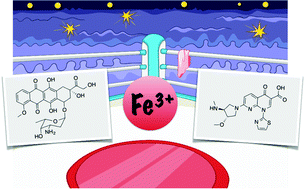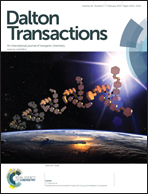Iron(iii)-binding of the anticancer agents doxorubicin and vosaroxin†
Abstract
The Fe(III)-binding constant of vosaroxin, an anticancer quinolone derivative, has been determined spectrophotometrically and compared with the analogous Fe(III) complex formed with doxorubicin. The in vivo metabolic stability and iron coordination properties of the quinolones compared to the anthracylines may provide significant benefit to cardiovascular safety. The mechanism of action of both molecules target the topoisomerase II enzyme. Both doxorubicin (Hdox, log βFeL3 = 33.41, pM = 17.0) and vosaroxin (Hvox, log βFeL3 = 33.80(3), pM = 15.9) bind iron(III) with comparable strength; at physiological pH however, [Fe(vox)3] is the predominant species in contrast to a mixture of species observed for the Fe:dox system. Iron(III) nitrate and gallium(III) nitrate at a 1 : 3 ratio with vosaroxin formed stable tris(vosaroxacino)-iron(III) and tris(vosaroxino)gallium(III) complexes that were isolated and characterized. Their redox behavior was studied by CV, and their stereochemistry was further explored in temperature dependent 1H NMR studies. The molecular pharmacology of their interaction with iron(III) may be one possible differentiation in the safety profile of quinolones compared to anthracyclines in relation to cardiotoxicity.


 Please wait while we load your content...
Please wait while we load your content...